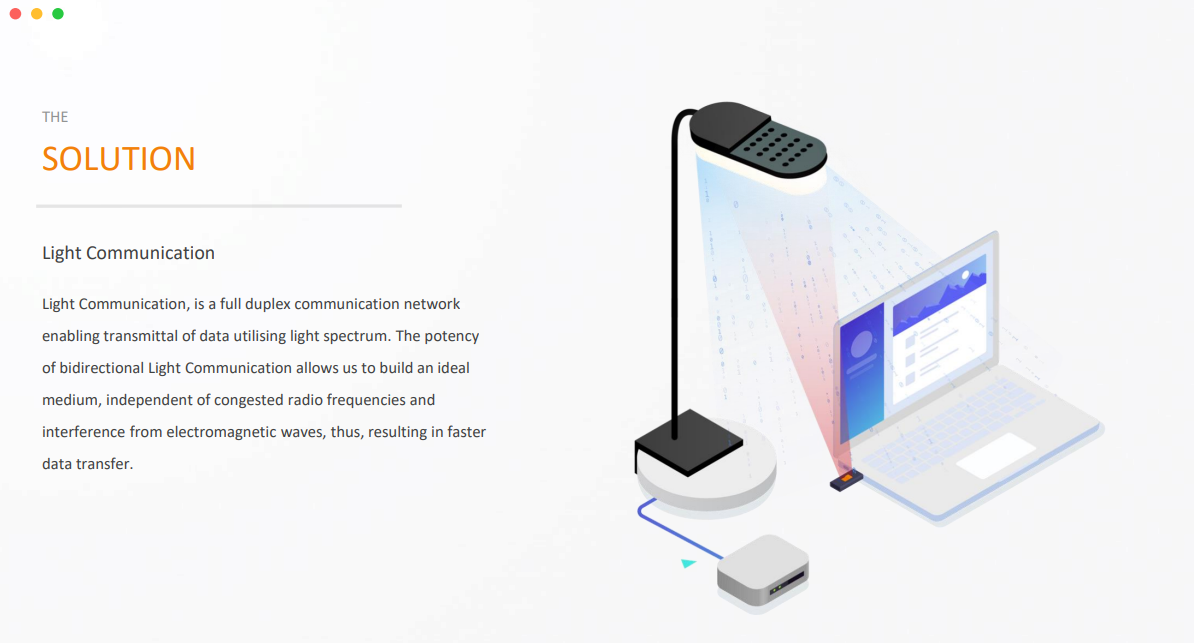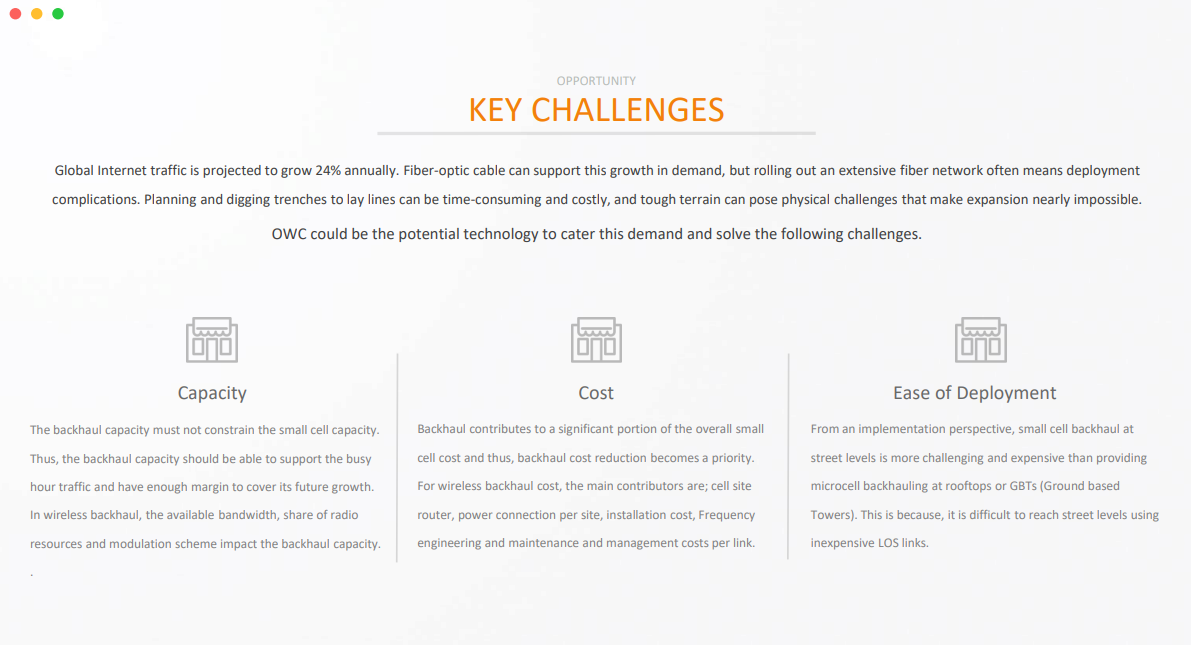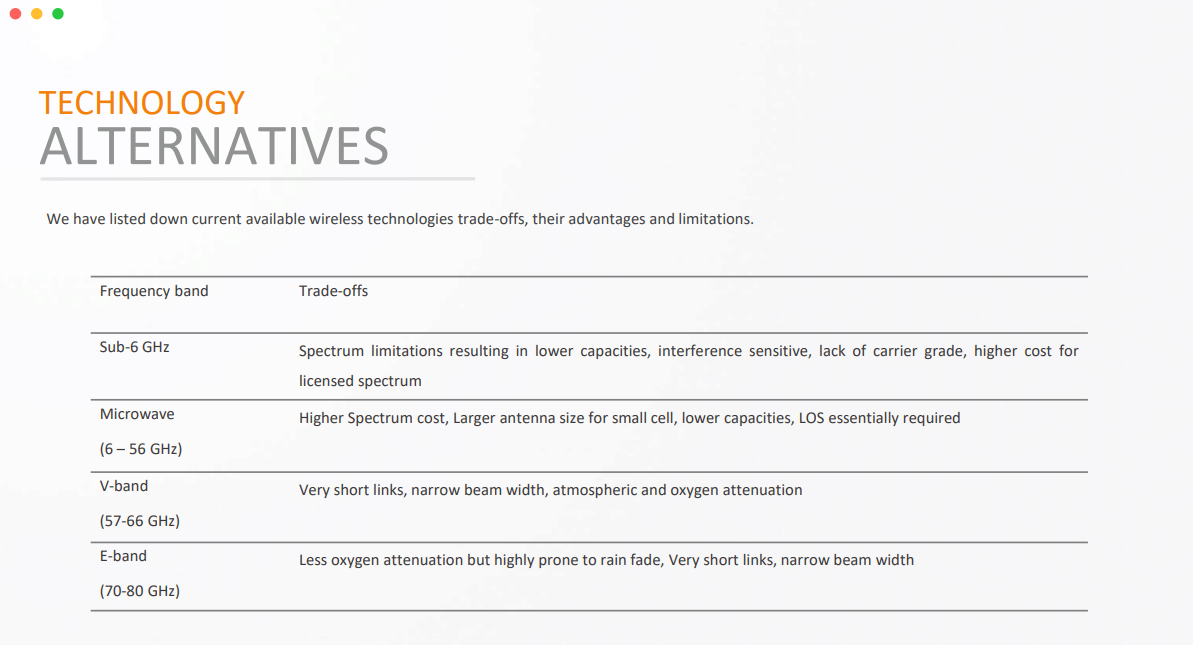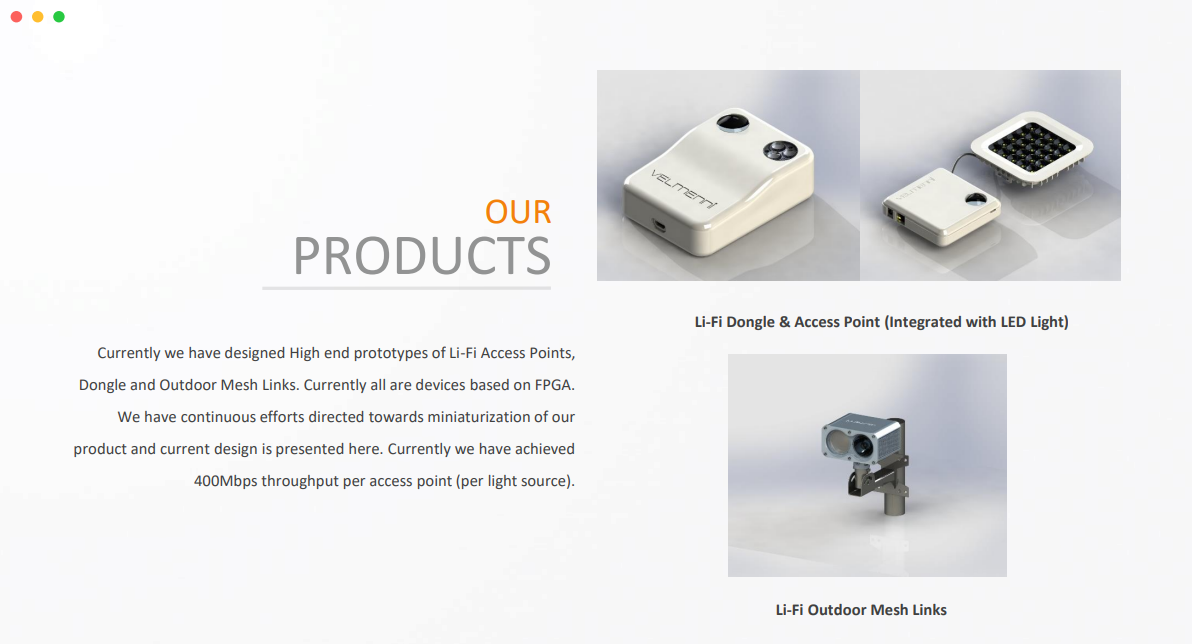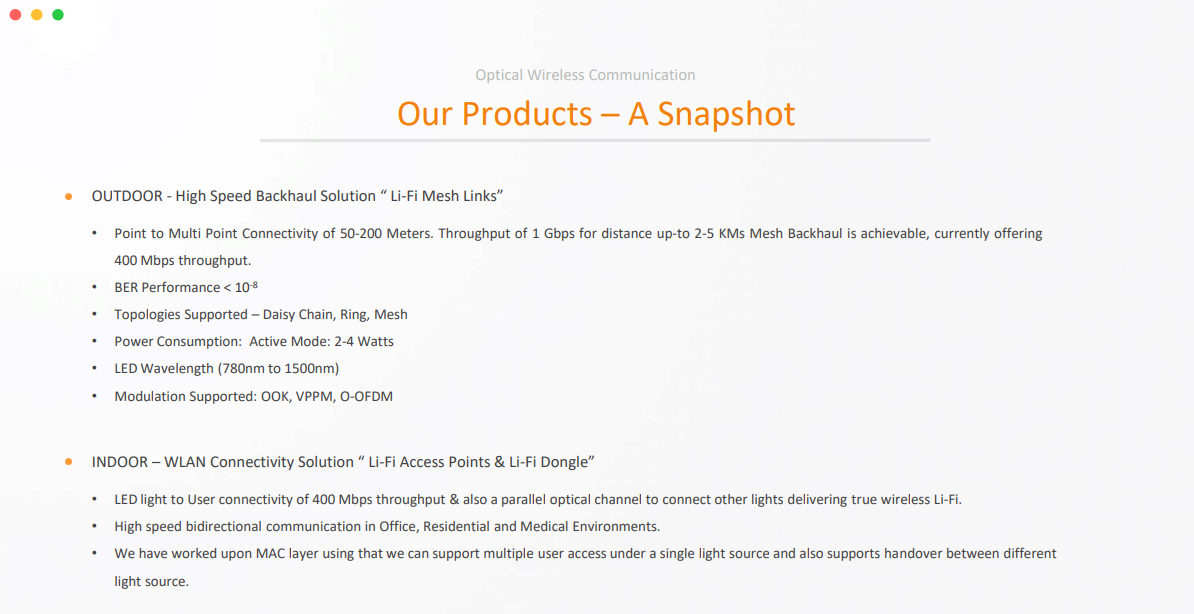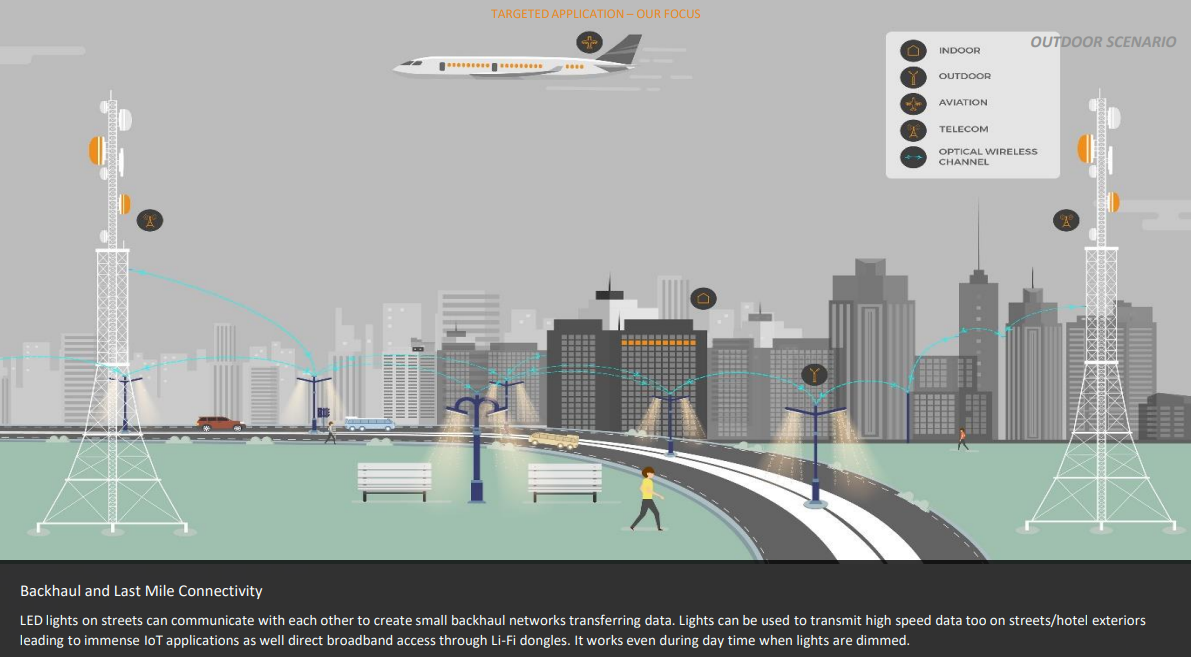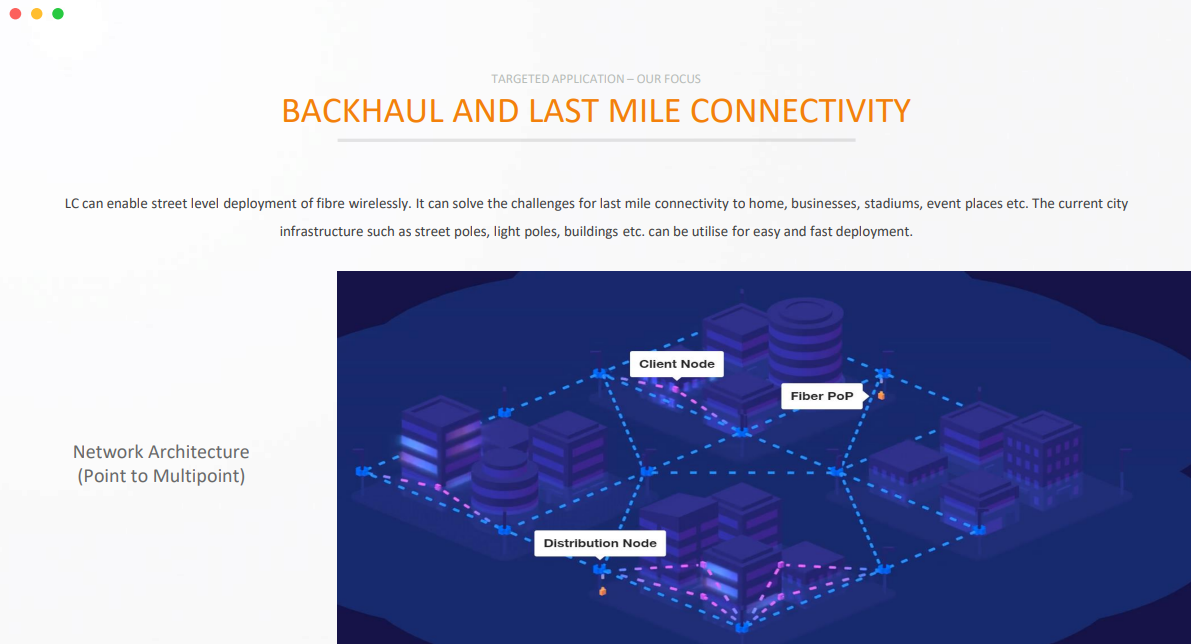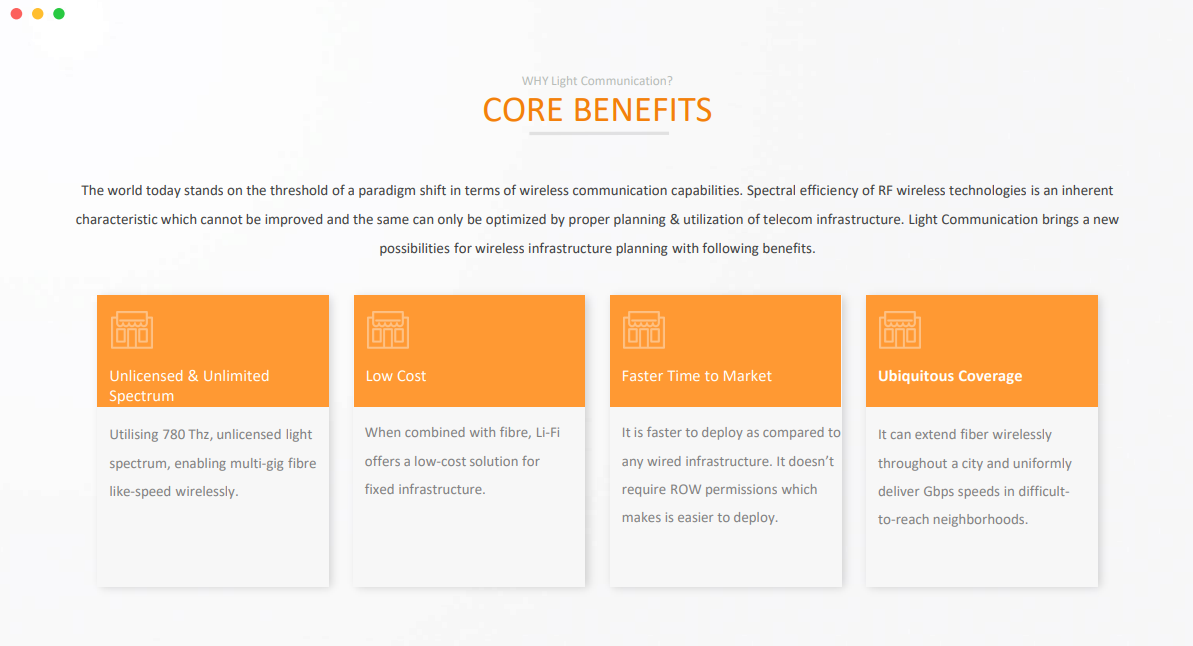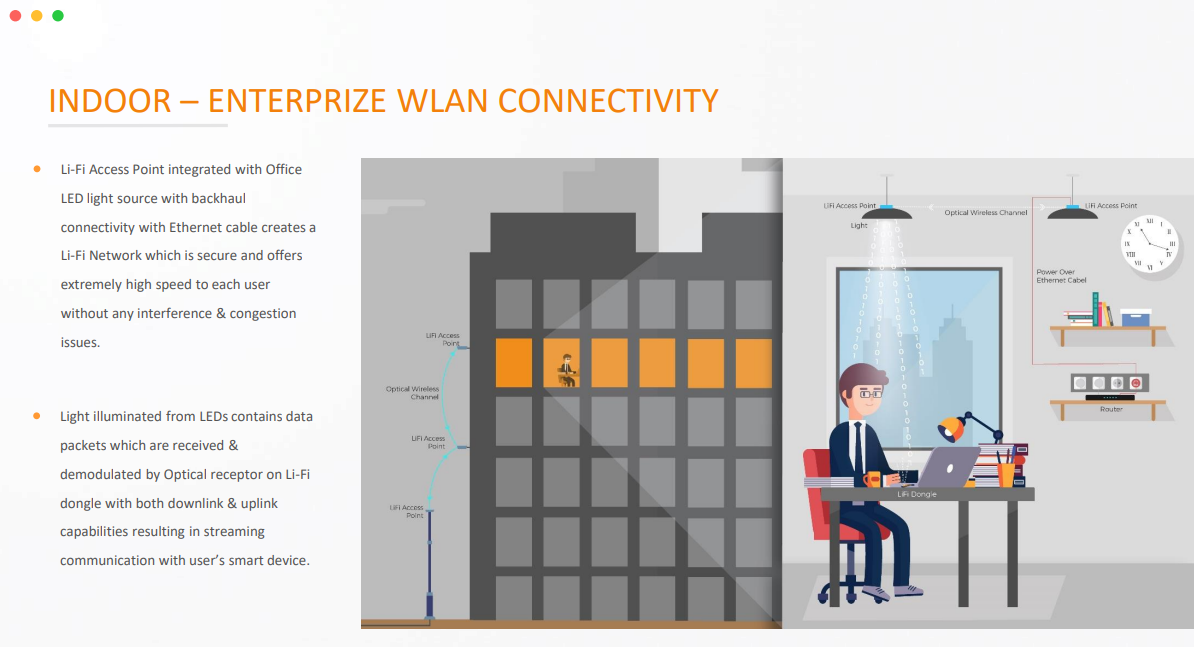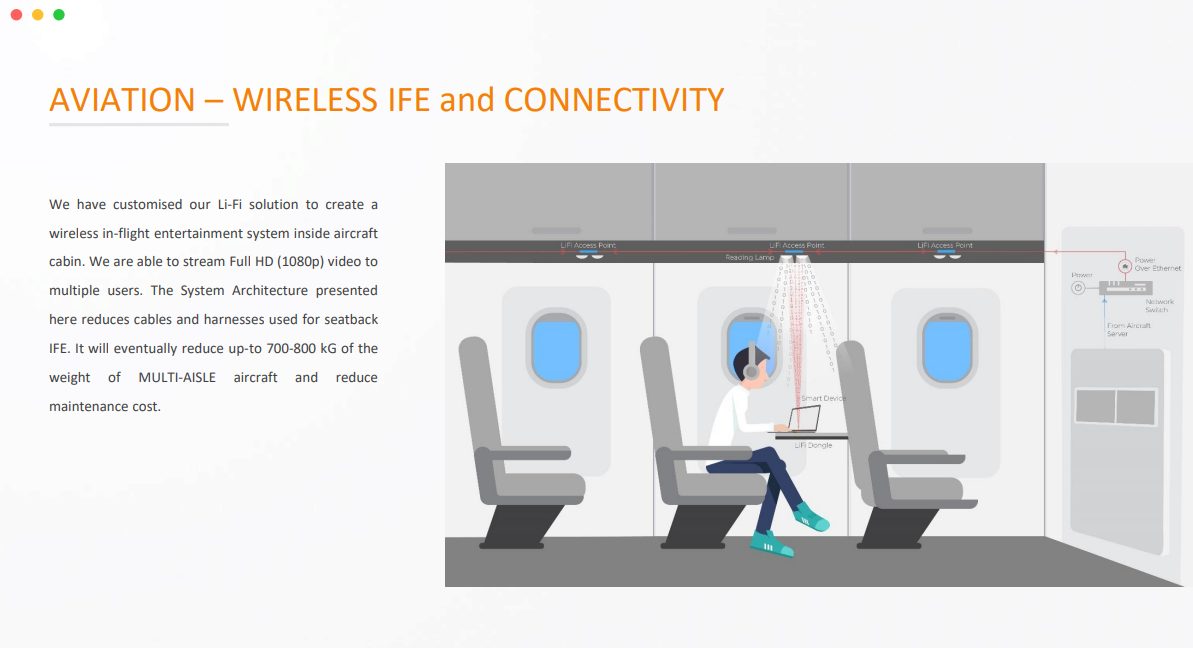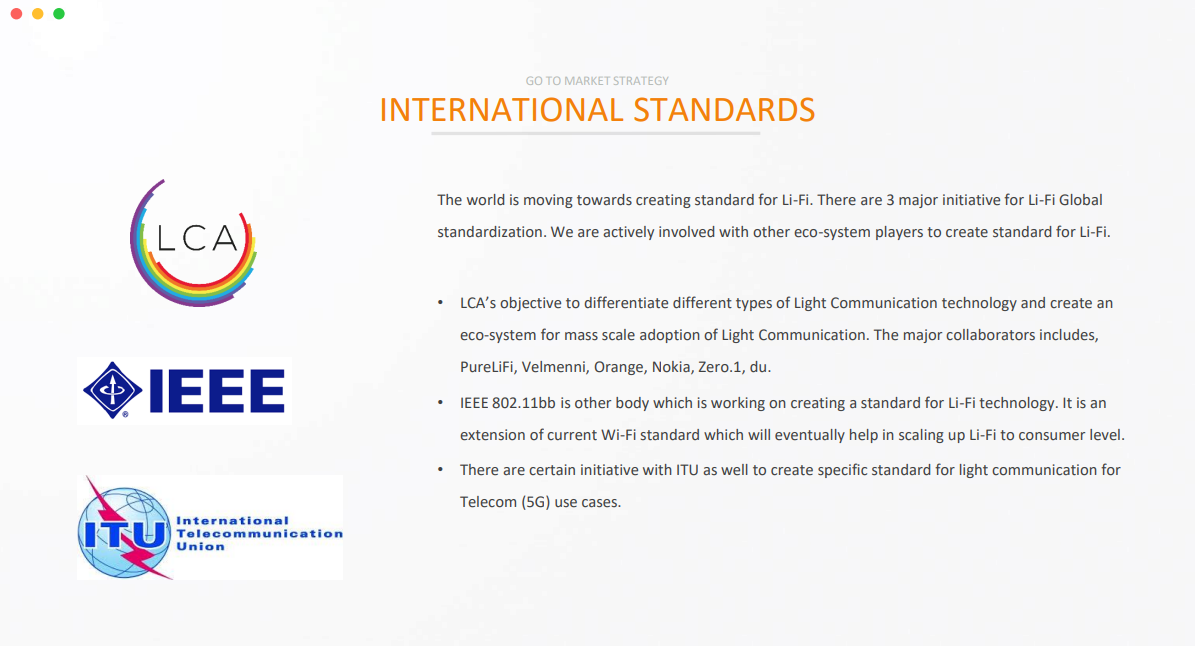Li-Fi Conference 2021 - Recap Part 7 - Light Communication As A Part Of 5G And Beyond
Li-Fi Conference 2021
In our last article from our ONLINE Li-Fi Conference 2021 recap series, we discussed the presentation on “LiFi For Education” delivered by Benjamin Azoulay from OLEDCOMM. The conference was organised by the Jakajima, the global High Tech Conference organiser, and the Light Communications Alliance.
Jakajima, Matchmaker for Innovators in the high tech industry, organises many events, ranging from LiFi Technology industry trends, 3D Printing to the Internet of Things, from Unmanned Cargo Aircraft to Health Tech, from 4D Printing to Photonics and from Vertical Farming to Sustainable Materials.
The online Li-Fi Conference included live presentations from researchers, executives and industry specialists from pureLiFi, Nokia, Signify, Orange, Radiocommunications Agency Netherlands, Velmenni, OLEDCOMM, HomeGrid Forum and Weidmüller Deutschland.
In another article recap series, we will talk about the presentation on Light Communication As A Part Of 5G And Beyond delivered by Deepak Solanki from Velmenni. Before this, we will talk about Velmenni.
Velmenni
Velmenni, having developed LiFi, now comes among one of the most valued organizations in the world of optical wireless data transmission. Founded in 2012, Velmenni became the first venture to explore the universe of visible light communications technology in India. With their prime product, LiFi, Velmenni is among the leading LiFi companies disrupting the world of data communication.
They have created a LiFi-based mesh network solution which helps in transferring data across long distances. The product makes setting up wireless networks in ground, motion & air possible, where optical cable infrastructure is difficult to implement. Their team has been working on LiFi for nearly 10 years. It has pioneered in achieving several technological milestones.
Their main focus is on optimisation of speed efficiency and seamless connectivity within the LiFi domain.
Light Communication As A Part Of 5G And Beyond Delivered By Deepak Solanki
Deepak Solanki, one of the founders and CEO at Velmenni, was the seventh presenter at the online Li-Fi Conference 2021. He discussed in his presentation the topic of Light Communication As A Part Of 5G And Beyond.
Deepak always had a keen eye for science-bound discoveries & inventions. Choosing electronic engineering as a lifelong pursuit, Deepak then defined his core to be aggressive & impactful R&D. He has participated in various projects from academic institutions like IIIT - Hyderabad & Sine IIT - Bombay while alongside publishing multiple research reports on mobile robotics. Recently he remedied one of the biggest Road Traffic Control issues in Delhi NCR, India. Today, he's conquering the ever-evolving start-up culture while constructing Li-Fi & disclosing its application in exciting new verticals.
Below are some points discussed about Light Communication As A Part Of 5G And Beyond:
VELMENNI’S ORIGIN
Deepak Solanki started his presentation by saying the following:
“Thank you, Peter, and good evening to all of you, my name is Deepak Solanki and I am the founder and CEO of Velmenni. Just to give you a brief about us. We are a startup based in India. And we have been in operation counted in back in 2012, and have been doing research in the light communication space for the past several years. Our objective was initially to focus on solving multiple challenges, building up light communication solutions, including work on fibre. So in the past several years, we have done different research on the technology and built up several kinds of solutions, which we are offering to end customers now and have been involved in building an ecosystem around light communication technologies”.
THE SOLUTION
”So, I think most of us understand that light communication is a full duplex bi directional communication technology, which utilises the entire light spectrum for sending data starting from 380 nanometers going up to 1100 nanometers, which covers up the visible part of light spectrum as well as the near infrared. So, the entire light spectrum can be utilised on creating a truly wireless network and just independent from radio frequencies. Depending on the use case, any different kinds of wavelengths of light can be utilised, and a product and solution can be created”.
OWC FEATURES
“So I think all of us understand that the light communication can offer several features. One of them is that the spectrum is truly freely available throughout the world. So there is no need to get the licence of spectrum from different authorities. And globally, most of our colleagues have shared that information earlier as well, the usable spectrum is quite bigger as compared to the radio frequency spectrum. We can achieve better data throughput as compared to the traditional radio based data communication system. We can go up to much higher in terms of at least the laboratory choice depending upon what kind of optical system you're using, you can achieve multi Gigabit ports in the light communication space. It's a safer technology in terms of EMF radiation. So, since we're not using any radio spectrum, so it's Radio Free, on the other hand, it can also provide really high data securities, most of us talked about the inherent properties of light, where the light can be concentrated to a specific area and in those particular areas, it becomes really secure because if somebody wants to enter into your system, they have to come under the light source which gives an extra layer of security as compared to the train traditional encryption which happens on the application layer.”
THE PROBLEM
“So, I think all of us can understand that the data demand in the last several years has been exponentially increased. So, what is the need of IT you know, we already have video based wireless communication and the cable infrastructure to provide connectivity to the end users and what is the need of a you know, an alternate technology or a new technology? I think the major reason being if you talk about the current either a wired infrastructure or a wireless infrastructure, both have their own challenges, and I would like to talk about more challenges in a practical implementation scenario, when we are talking about a mobile network. In this presentation, I will specifically focus on outdoor backfill use cases of light communication technologies. My colleagues from pureLifI, Signify, and OLEDCOMM have talked about use cases which are more focused for indoor communication. I would like to bring a new perspective where and and a targeted use case where we can talk about outdoor communication and you know look to contribute and inform and to contribute into building up a secured connected wireless infrastructure in outdoor space”, said Deepak Solanki.
KEY CHALLENGES
“So, if I talk about the current mobile networks, I come from a very densely populated country. We have 1.2 billion is our population and other cities are really big and congested. I live in New Delhi which is which has 13 million population in a single city. So there are a lot of congestion issues when I talk about the mobile network. So if I say we have a 4G right now available and in the 4G network, the average data throughput is less than 10 megabits per second hand. And even though there are so many areas within the cities where the connectivity is really cool. So the major challenge, if I talk about for telecom operator to build up a stronger connected infrastructure deploying more denser small cells within the cities, and that can be done, which requires a lot of investment, that's one thing. And then the backhaul becomes a big challenge in a city kind of an infrastructure where the Tensor Networks are there. So generally, to cater this kind of a demand, a telecom operator has to set up small cells at every 200 meters within the cities, and which is really complex to do that. And the battle becomes very challenging when you're deploying a street level, you know, small cells, so the backup can be done through optical fibre cables. But in developing nation, building up a fibre cable infrastructure takes a lot of time. It's expensive. And secondly, it's not easy to do that, because there are challenges in terms of trenching the streets, some of the areas you don't have the space to trench the streets and lay down a fibre cable. So, there is a requirement of wireless backhaul in those particular areas and the use cases and there are several technology which are available which can solve that kind of a challenge, but they come up with their own issues that are alternate technologies in any radio band.”
TECHNOLOGY ALTERNATIVES
“We have V-band, E-band, microwave and all of them have certain trade-offs in terms of reliability of the connection in terms of, you know, having the condition into the network. So, if you talk about the ISN band based radio solution, they face a lot of issues in terms of congestion within the cities. So, I think the light communication technologies can offer a very interesting solution in those areas. It's a part of free space optical communication from a taxonomy point of view. Nikola shared in his previous talk about different taxonomies, we have LIFI which is used for indoor communication network, similar to Wi-Fi, we have OCC then we have free space optical communication. So, these outdoor products which can provide back full connectivity can come under free space optical communication, you know, there are various solutions, which can be made off depending upon what kind of throughput and a distance is required to communicate, but the objective of these kinds of solution is to basically complement the cable infrastructure. So, in the areas wherever you cannot lay down a fibre cable or an Ethernet cable, these devices can be integrated into the field and can provide the value as connectivity and replace the cable from the infrastructure.”
OUR PRODUCTS
“So, I would like to talk about some of the products that we have built up, we do have a you'd say the traditional LIFI solution, which is meant for indoor use cases, but I would like to talk about outdoor product which is in point to point or point to multipoint communication system, which can work in outdoor scenarios and can basically complement the fibre cable infrastructure. So, on the bottom of the slide, we have our LIFI outdoor machines. We call it LIFI and because we use a similar kind of physical layer, which has been utilised in light communication system and then we are using NBS as a optical front end for this one. So it's basically an LED based outdoor solution.”
Our Products – A Snapshot
“Some of the features of this product is the backlog product can be utilised to provide short distance point to point connectivity in where we can go up to 200 metres and up to a gigabit throughput can be achieved. Some of the interesting thing about this product is we can actually do point to point communication and also can enable long distance communication while building up a daisy chain network. So, we can send data from one point to another point second to the third, third to the fourth and can make a decision about other networking topologies such as sharing information and also can be implemented onto our product. So, for that, we have a specific node which can send data into multiple direction and can enable point to multipoint connectivity. So, that is also what we are offering as a product and I would like to talk more about that in the later slide. Different kinds of wavelengths can utilise into this product measured in the near infrared region. So, it can work from 780 nanometers to 1500 nanometers. So, though the wavelength is fixed into our product, but yes, it does have the option to choose wavelength depending upon what kind of environmental conditions we would like to use the product”.
TARGETED APPLICATION – OUR FOCUS
“So, how we can utilise it. One thing is, like I mentioned this product can be utilised for backhaul connectivity. In making the connection between the cell towers or from a cell tower to a small cell, all those kinds of battery connectivity can be provided with this product. Secondly, a street level deployment can be done. So, since the device is very small and consumes very less power, it can be directly integrated within the cities on a smartphone and can do a wireless backhaul to the pole. So, in that kind of a network, these are our product can take data from you know a sensor which has been integrated on a pole or even though the security cameras so, the feed from the camera can be taken in bringing into the network wirelessly and even it can provide the backhaul to the WI-FI access points, which can be integrated in a smart city kind of an infrastructure. So, this can complement and can become a part of coming 5g networks. So, in the 5g, the small cell deployments are going to be really dense within the cities you know, there is going to be small cells at every 100 or 150 metre within the cities and specifically in density area, the distance between the small cell will work to reduce a lot. So, the backhaul to those types of small cells can be done through FSO or light communication devices”.
BACKHAUL AND LAST MILE CONNECTIVITY
“So, this is one of the use cases that we have been focused upon. And we have done some of the real time deployments which I will talk later into the presentation. But more about on the deployment perspective how this product can be deployed. One thing is, we can have a starting node into the network, which can get the backhaul from a fibre from fibre POV, you can directly plug in the fibre input to as an input to like a source device, the source device can send data into multiple direction, it can also enable point to point connectivity but we have shown a point to multipoint architecture where the middle nodes can be distribution nodes can be integrated either on a phone or on a building. They can get data from different directions from different devices and can build up a stronger backhaul network. And this platform can be utilised like I mentioned either for small cell phone, smart poles or even though to provide the last mile connectivity in a broadband use cases. Some of the features of this product if I try to utilise this topology in that case, we can offer a truly mesh network and depending depending upon what kind of redundancy is required, we can choose a number of paths for sending data and if there is a blockage, which comes in any other part, our system can do an auto rerouting which means it can send data to distribution and declining nodes automatically from a different path. So, there is always a backup channel for sending data if there is a disruption in the network. So in this way, we can have a really redundant network which is required if we talk about mobile backhaul link. And we can offer 99.99% uptime in those cases”.
CORE BENEFITS
“Some of the benefits of utilising that kind of network is it's low cost as compared to fibre infrastructure because fibre infrastructure requires trenching of trees taking Arado to write of a permissions and which costs a lot in cities. Secondly, the time to market replaces drastically. So if you wanted to build up a 5g network, specifically in India, where the cities are really congested and really big, if we go with the traditional way and bring the backhaul through the fibre, it is going to take maybe 10 years to deploy a 5g network. So to reduce that time to market, light communication could be a very interesting solution. And light communication based wireless backhaul, I mean they are interesting solution. So apart from that, like if they're working in an unlicensed spectrum, so it can be deployed anywhere in the world without taking permission and spending time. Basically taking those commissions from the government, it can provide ambitious coverage and extend the wireless high fibre wirelessly. So now these are the certain core benefits. I've mentioned this before that we can reduce the time to market as well as I can basically build up a wireless network or bring data to the end user in a case where the optical fibre cables are difficult to deploy”.
INDOOR – ENTERPRIZE WLAN CONNECTIVITY
“I would also like to talk about some of the other use cases which are more indoor scenarios. So we can, like the other companies, offering solution indoor connectivity where the user device can be connected to the LIFI network. So, we do have a product which is based upon our access point and a dongle at this moment and we are also looking forward to build up the miniaturised version and working in the ecosystem to bring those use cases also to the market APAC use case”.
“From my ecosystem perspective, I guess most of our colleagues have talked about building up a LIFI ecosystem or a light communication ecosystem. So, LCA is one of the major alliances around like communication technologies. So, we all the industry players are working together to do the education around light communication technology, building up the use cases and bringing the product to the market”.
“So, the standardisation is way too important for us and once we have the standardisation, we can look forward to mass induction of the technology”.
You can also watch the full video presentation on the following YouTube link from Jakajima YouTube channel.
Li-Fi Conference 2022
The next Li-Fi Conference is coming up on the 28th of June 2022 between 10 am and 4.30 pm CET.
It is interesting to realise that lights that illuminate offices, homes, cars, factories, our streets and more locations also can connect us to data and hence power the growing demand for connectivity and speed.
At this conference professionals from all over the globe will gather together in order to share applications, ideas, new developments and ways to integrate Li-Fi in services, both for consumers and professionals.
This conference will be held Live and Online. The venue will be the High Tech Campus 1, The Strip 5656 AE Eindhoven The Netherlands.
Online tickets can be bought at the following link:
https://tikcit.com/register/61e002336d7fc4b6745cab83/
What is LiFi?
LiFi, also known as "Light Fidelity" is a wireless optical networking technology, which uses light-emitting diodes (LEDs) to transmit data. In 2011, professor Harald Haas made a LiFi demonstration at the TED (Technology, Entertainment, Design) Global Talk on Visible Light Communication (VLC).
VLC uses light as a medium to deliver high-speed communication like Wi-Fi and complies with the IEEE standard IEEE 802.15.7. The IEEE 802.15.7 is a high-speed, bidirectional, and fully networked wireless communication technology-based standard similar to Wi-Fi's IEEE 802.11.
How does LiFi work?
LiFi is a high speed, bidirectional, and fully networked wireless communication of data using light. LiFi constitutes of several light bulbs that form a wireless network.
When an electrical current goes through to a LED light bulb, a stream of light (photons) emits from the lamp. LED bulbs are semiconductor devices, which means that the brightness of the light flowing through them can change at extremely high speeds. The signal is sent by modulating the light at different rates. The signal can then be received by a detector that interprets the changes in light intensity (the signal) as data. Also when the LED is ON, you transmit a digital 1, and when it is OFF, you transmit a 0.
LiFi Benefits
The primary benefits of LiFi are as follows:
• Security: Provides entirely secure access. Where there is no light there is no data.
• Safety: Does not produce electromagnetic radiation and does not interfere with existing electronic systems.
• Localisation: Allows localisation due to the small coverage area of LiFi access point - localisation can be used for very precise asset tracking.
• Data density: Provides ubiquitous high-speed wireless access that offers substantially greater data density (data rate per unit area) than RF through high bandwidth reuse.
Credit to Oledcomm
LiFi Applications
LiFi can be used for so many applications and the list is increasing every year. You can read our updated list of Li-Fi applications at the following link:
Credit to pureLiFi
In conclusion, if you are also interested to hear more information about the OWNII Coin or enquire about LiFi devices such as the LiFiMax and Trulifi, you can contact us through our chatbot or by sending an email through our contact us form. If you enjoyed this post and would like to hear more updates about LiFi technology, subscribe to our newsletter. Don’t forget to subscribe to our social media accounts. You can also join our Telegram group about LiFi technology on this link:
https://t.me/joinchat/FMzOmsEKyJFrU6Af






